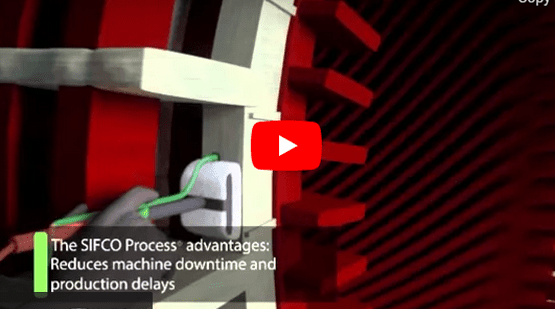Our portable process can be used to repair turbine components, bus bars, switchgear, diesel engine components, valves, generators, nuclear components and containment vessels. This can be done either in the workshop or in any environment where the component may be located.
BUS BARS: Lower electrical contact resistance.
CONTAINMENT VESSELS: Touch up electroless nickel coatings.
DIESEL ENGINES: Resize turbocharger bearing journals. Restore sleeve seats. Repair crankshaft and camshaft bearing diameters. Salvage bearing saddles.
GENERATORS: Repair bearing housings, rotor journals and commutators.
NUCLEAR COMPONENTS: Repair circular pump rotor air seal areas. Apply optical coating to fuel bundle shuttles. Hardcoat to resize bores of hydraulic stud tighteners. Restore seal areas on air lock flanges. Etch hot spots to remove alpha-radiating ferric flock.
TURBINES: Resize turbine shaft couplings, steering diameters, bearing journals, and turbine wheels. Repair turbine casing steam cuts. Apply prebraze coatings to turbine blades and wheels.
VALVES: Repair defects in seat areas of gate, disc and needle valves. Restore worn packing areas on valve stems.
Case History
A personnel air lock head ring (flange) was plated with 0.040″ thickness of copper and hand worked to ensure a good seal with the o-ring and the mating part. It was then capped with 0.004″ thickness of nickel.
Bores on an aluminum hydraulic stud tightener were hardcoat anodized with a coating thickness of 0.002″ for dimensional restoration and to provide a more durable surface.
Two faces on the outside diameter, the vane area, of a low pressure steam turbine disc were repaired with a 0.003″ thick deposit of nickel. This 7000 pound component was plated on site, in a horizontal position.
Collector rings from a generator armature were coated 0.002″ thick with non-cyanide silver to replace defective tank plated silver.
Industry Specific Applications – Power Generation & Distribution – Bus Bars – On-Site Silver Plating
Optimizing current flow is a primary concern for the Electric Power Industry, especially in the transmission and distribution process. One key ingredient is providing and maintaining stable, conductive joints.
Field experience and laboratory studies have shown that this is especially true in the case of bus bars. Plated bus bars out-perform non-plated bus bars since they provide stable contact resistance and a low maximum operating temperature that increases the service life of the bus joint. Brush plating provides a simple, cost effective upgrade and repair solution for on-site silver plating of copper and aluminum bus systems.
 The world’s leaders in the power generation industry use selective brush plating and SIFCO ASC services to enhance and repair a multitude of turbine components.
The world’s leaders in the power generation industry use selective brush plating and SIFCO ASC services to enhance and repair a multitude of turbine components.
 Chinese (Simplified)
Chinese (Simplified)  English (UK)
English (UK)  French
French  German
German  Spanish
Spanish  Swedish
Swedish 
